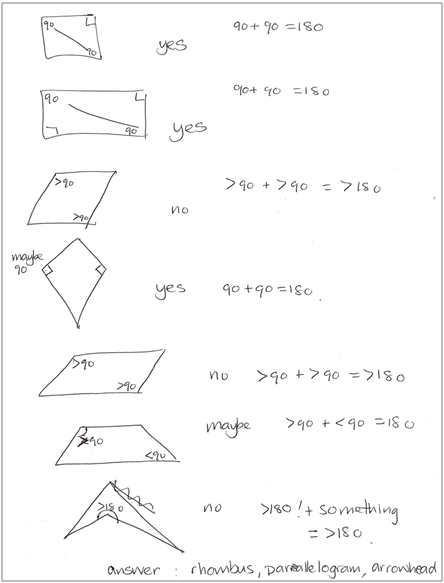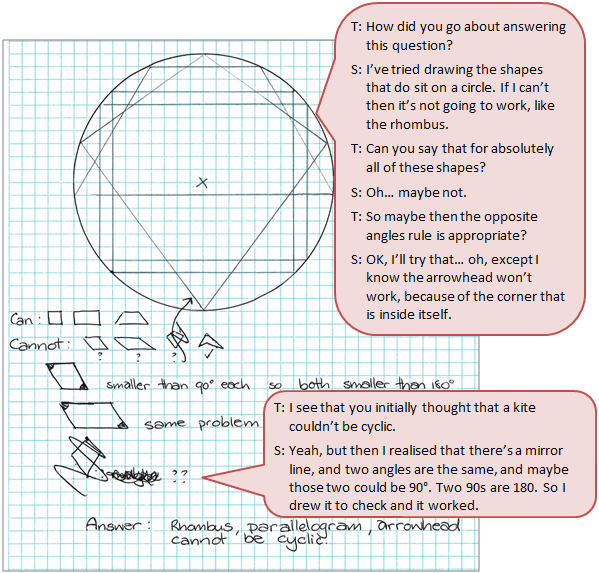The purpose of this activity is to engage students in considering geometric properties when categorising shapes.
This activity assumes the students have experience in the following areas:
- Classifying polygons, especially quadrilaterals.
- Measuring angles.
- Working with angle properties of polygons to find unknown angles.
The problem is sufficiently open ended to allow the students freedom of choice in their approach. It may be scaffolded with guidance that leads to a solution, and/or the students might be given the opportunity to solve the problem independently.
The example responses at the end of the resource give an indication of the kind of response to expect from students who approach the problem in particular ways.

A cyclic quadrilateral is a four sided shape which has the following properties:
- All four vertices lie on the circumference of a single circle.
- Opposite interior angles sum to 180°.
Which of the following cannot be a cyclic quadrilateral?
- a square
- a rectangle that is not a square
- a rhombus that is not a square
- a kite that is not a rhombus
- a parallelogram that is not a rhombus
- a trapezium that is not a parallelogram
- an arrowhead.
The following prompts illustrate how this activity can be structured around the phases of the Mathematics Investigation Cycle.
Make sense
Introduce the problem. Allow students time to read it and discuss in pairs or small groups.
- Do I understand the situation and the words? (Students may need support to understand the geometric language, especially terms like cyclic quadrilateral, angle sum, and circumference.)
- What will you need to know to solve the problem? (A definition of each class of quadrilateral is needed.)
- Can I draw or sketch the situation, including the different types of quadrilateral?
- What will a solution to this problem look like?
- What part of the problem could I get started with?
Plan approach
Discuss ideas about how to solve the problem. Emphasise that, in the planning phase, you want students to say how they would solve the problem, not to actually solve it.
- What do the conditions for a cyclic quadrilateral tell you about the shapes that will work? (Opposite angles adding to 180⁰ means the angles must be 90⁰ if the shape is symmetric. If the quadrilateral has vertices on a circle, it must have a centre. Each vertex must be the same distance from the centre.)
- What different quadrilateral shapes are included in each class? How will I check all the possible shapes and not miss any?
- Could I make drawings to help me visualise the quadrilaterals within a circle?
- What tools (digital or physical) could help my investigation? (A design package like Geogebra will allow students to set up a quadrilateral within a circle, manipulate the position of the vertices, and see which shapes work.)
- What sources might I need to use to get more information?
Take action
Allow students time to work through their strategy and find a solution to the problem.
- Have I worked in a systematic way, taking one class at a time, and exploring all the possible shapes?
- Are the tools I am using working well? What else could I try?
- Does my solution answer the question? How do I know that I have not missed something?
- What is my way to describe whether, or not, a class of quadrilateral is cyclic? Are all shapes within the class cyclic?
- Have I covered all the possible cases, or may I have missed some?
- How do my results compare with those of others?
Convince yourself and others
Allow students time to check their answers and then either have them pair share with other groups or ask for volunteers to share their solution with the class.
- What is the solution?
- Is my working clear for someone else to follow?
- How would I convince someone else I am correct?
- Could I have solved the problem in a more efficient way?
- What could I try differently next time?
- Is there some mathematics that I need to learn?
- If I have another problem like this one, what strategies would I use? Why?
Examples of work
Work sample 1
The student uses geometric reasoning and/or exploration, to check that each quadrilateral meets the conditions for being a cyclic quadrilateral. However, they do not check to see if each quadrilateral can be drawn with a circle.
Click on the image to enlarge it. Click again to close.
Work sample 2
The student uses geometric reasoning and/or exploration, to check that each class of quadrilaterals meets the conditions for being a cyclic quadrilateral. They consider that all, only some, or none, of the quadrilaterals within a class meet the criteria.

